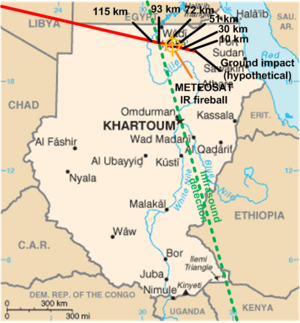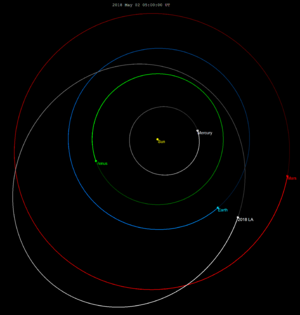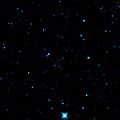Asteroid impact prediction facts for kids
Asteroid impact prediction is all about knowing when and where space rocks, called asteroids, might hit Earth. Most asteroids won't hit our planet. This prediction work helps us find the ones that could. It also helps us find asteroids that might hit Earth in the future.
It's easier to spot big asteroids. We can see them from far away, many years before they get close to Earth. But there are millions of smaller space rocks. They are usually too dim to see until they are very close to Earth. We use telescopes to find asteroids that might hit Earth soon. However, our telescopes are not always good enough to see small asteroids. This means we almost never see them before they actually hit Earth.
Contents
How NASA Tracks Asteroids
The IAU Minor Planet Center (MPC) keeps track of all asteroid information worldwide. NASA has a special system called the Sentry System. It constantly checks the MPC asteroid information. It looks for any asteroids that might hit Earth in the future. So far, it hasn't found any that are a sure threat.
The asteroid that has the highest chance of hitting Earth is called 2010 RF12. NASA thinks it will pass by Earth in September 2095. They believe it has less than a 1 in 10 chance of hitting our planet.
Getting Better at Predicting Impacts
In the early 2000s, predicting asteroid impacts was very difficult. Most of the time, when an asteroid hit Earth, it was a surprise. NASA wants to get better at this. They plan to build more powerful telescopes.
One very large new telescope is being built in northern Chile. It's called the LSST. This telescope is huge and will take years to finish. It should be ready around 2023. Once it's working, this powerful telescope will be much better at finding small asteroids.
Telescopes on Earth can only see part of the sky. They can't see asteroids coming from near the Sun. This is because of the bright blue sky during the day. A telescope in space doesn't have this problem. It can see much more of the sky around Earth. It can also keep looking all day and night. There are no clouds or rain in space to block its view.
Space telescopes can also use infrared heat radiation to find asteroids. This is a great way to spot them. This method doesn't work well on Earth because the warm air hides the heat from asteroids. Space telescopes are better in many ways, but they cost more money. They also don't last as long as telescopes on the ground.
In 2017, NASA came up with many ideas to help find smaller asteroids. They want to find 9 out of 10 asteroids that are bigger than 140 metres. That's about as long as two jumbo jets. These ideas should also help find asteroids smaller than 140 metres. Many of these ideas involve using a new ground telescope along with a new space telescope. The LSST is an example of a ground telescope. NEOCAM is an example of a space telescope, but it hasn't been built yet.
These new telescopes will be expensive. NASA has already done most of the work finding asteroids. They have found more than 9 out of 10 of all asteroids ever discovered. Asteroids can hit anywhere on Earth, not just the USA where NASA is located. Because of this, the United States government asked NASA to find other countries to help. They need help building and paying for these telescopes.
When Prediction Worked
Below is a list of times when we successfully predicted an asteroid impact. In these cases, the space rocks that hit Earth were not a surprise. There are many asteroids that will hit Earth in the future. They are not on this list because we don't know about them yet. If we get better at predicting asteroid impacts, we will find out about them. Then we will know which asteroids are heading our way in the future.
| Day the Space Rock Hit Earth | Day the Space Rock was First Seen | Name of the Space Rock | Size in Metres |
Speed miles per hour |
|---|---|---|---|---|
| 7 October 2008 | 6 October 2008 | 2008 TC3 | about 4 metres | 29 000 mph |
| 2 January 2014 | 1 January 2014 | 2014 AA | about 3 metres | unknown |
| 2 June 2018 | 2 June 2018 | 2018 LA | about 3 metres | 38 000 mph |
See Also
Images for kids
-
One of the 7,000 buildings damaged by the 2013 Chelyabinsk meteor.
-
Viewed from space by WISE using a thermal camera, asteroid 2010 AB78 appears redder than the background stars. This is because it gives off most of its light as infrared heat. In regular light, it is very faint and hard to see.







